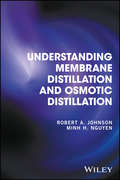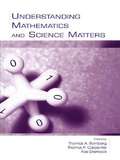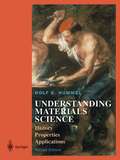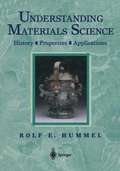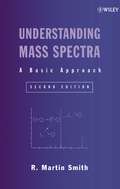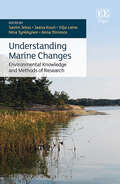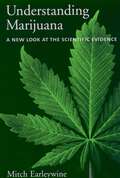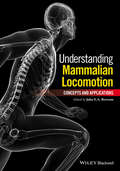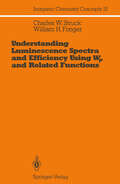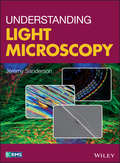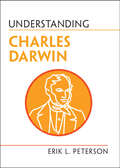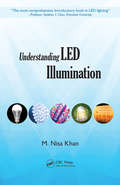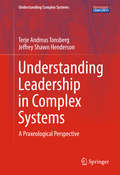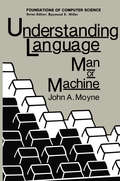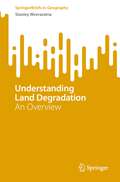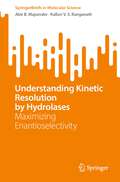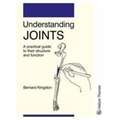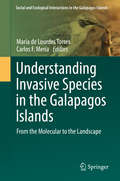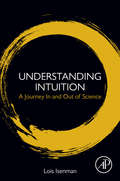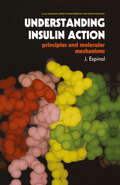- Table View
- List View
Understanding Membrane Distillation and Osmotic Distillation
by Robert A. Johnson Minh H. NguyenThis book addresses principles and practical applications of membrane distillation and osmotic distillation, separation technologies which are gaining increasing attention due to their advantages over conventional concentration processes.• Addresses membrane and osmotic distillation, two closely related and novel processes that offer several advantages over conventional concentration processes• Has a widespread impact and application of the technology in industries such as food, environment, and nuclear clean-up / containment• Covers theoretical aspects of both processes, the properties of hydrophobic membranes, process economics, integrated processes and future prospects.• Caters the presentation caters for the diversity of readership with respect to links with membrane technologies.
Understanding Membrane Distillation and Osmotic Distillation
by Robert A. Johnson Minh H. NguyenThis book addresses principles and practical applications of membrane distillation and osmotic distillation, separation technologies which are gaining increasing attention due to their advantages over conventional concentration processes.• Addresses membrane and osmotic distillation, two closely related and novel processes that offer several advantages over conventional concentration processes• Has a widespread impact and application of the technology in industries such as food, environment, and nuclear clean-up / containment• Covers theoretical aspects of both processes, the properties of hydrophobic membranes, process economics, integrated processes and future prospects.• Caters the presentation caters for the diversity of readership with respect to links with membrane technologies.
Understanding Mathematics and Science Matters (Studies in Mathematical Thinking and Learning Series)
by Thomas A. Romberg Thomas P. Carpenter Fae DremockThe research reported in this book provides reliable evidence on and knowledge about mathematics and science instruction that emphasizes student understanding--instruction consistent with the needs of students who will be citizens in an increasingly demanding technological world.The National Center for Improving Student Learning in Mathematics and Science--established in 1996 as a research center and funded by the U.S. Department of Education--was instrumental in developing instructional practices supportive of high student achievement in and understanding of mathematics and science concepts. NCISLA researchers worked with teachers, students, and administrators to construct learning environments that exemplify current research and theory about effective learning of mathematics and science. The careful programs of research conducted examined how instructional content and design, assessment, professional development, and organizational support can be designed, implemented, and orchestrated to support the learning of all students. This book presents a summary of the concepts, findings, and conclusions of the Center's research from 1996-2001.In the Introduction, the chapters in Understanding Mathematics and Science Matters are situated in terms of the reform movement in school mathematics and school science. Three thematically structured sections focus on, respectively, research directed toward what is involved when students learn mathematics and science with understanding; research on the role of teachers and the problems they face when attempting to teach their students mathematics and science with understanding; and a collaboration among some of the contributors to this volume to gather information about classroom assessment practices and organizational support for reform.The goal of this book is to help educational practitioners, policymakers, and the general public to see the validity of the reform recommendations, understand the recommended guidelines, and to use these to transform teaching and learning of mathematics and science in U.S. classrooms.
Understanding Mathematics and Science Matters (Studies in Mathematical Thinking and Learning Series)
by Thomas A. Romberg Thomas P. Carpenter Fae DremockThe research reported in this book provides reliable evidence on and knowledge about mathematics and science instruction that emphasizes student understanding--instruction consistent with the needs of students who will be citizens in an increasingly demanding technological world.The National Center for Improving Student Learning in Mathematics and Science--established in 1996 as a research center and funded by the U.S. Department of Education--was instrumental in developing instructional practices supportive of high student achievement in and understanding of mathematics and science concepts. NCISLA researchers worked with teachers, students, and administrators to construct learning environments that exemplify current research and theory about effective learning of mathematics and science. The careful programs of research conducted examined how instructional content and design, assessment, professional development, and organizational support can be designed, implemented, and orchestrated to support the learning of all students. This book presents a summary of the concepts, findings, and conclusions of the Center's research from 1996-2001.In the Introduction, the chapters in Understanding Mathematics and Science Matters are situated in terms of the reform movement in school mathematics and school science. Three thematically structured sections focus on, respectively, research directed toward what is involved when students learn mathematics and science with understanding; research on the role of teachers and the problems they face when attempting to teach their students mathematics and science with understanding; and a collaboration among some of the contributors to this volume to gather information about classroom assessment practices and organizational support for reform.The goal of this book is to help educational practitioners, policymakers, and the general public to see the validity of the reform recommendations, understand the recommended guidelines, and to use these to transform teaching and learning of mathematics and science in U.S. classrooms.
Understanding Materials Science: History, Properties, Applications, Second Edition
by Rolf E. HummelThis introduction for engineers examines not only the physical properties of materials, but also their history, uses, development, and some of the implications of resource depletion and materials substitutions.
Understanding Materials Science: History · Properties · Applications
by Rolf E. HummelThis introduction for engineers examines not only the physical properties of materials, but also their history, uses, development, and some of the implications of resource depletion and materials substitutions.
Understanding Mass Spectra: A Basic Approach
by R. Martin SmithUnderstanding Mass Spectra: A Basic Approach, Second Edition combines coverage of the principles underlying mass spectral analysis with clear guidelines on how to apply them in a laboratory setting. Completely revised from the first edition, an updated and unified approach to mass spectral interpretation emphasizes the application of basic principles from undergraduate organic, analytical, and physical chemistry courses. A detailed overview of theory and instrumentation, this useful guide contains step-by-step descriptions of interpretative strategies and convenient lists and tables detailing the information needed to solve unknowns. Other features include real-world case studies and examples, skill-building problems with clearly explained answers, and easy-to-follow explanations of the important mathematical derivations.
Understanding Marine Changes: Environmental Knowledge and Methods of Research
Studying environmental changes to the seas and oceans through a variety of perspectives and disciplines, this pioneering book outlines the challenges of researching marine environmental issues.With no linear cause-and-effect relationship between marine environmental changes and the often human-induced stressors which produce them, the changes to our seas and oceans are complex and uncertain, arising from multiple and interconnected issues. Bringing together academic expertise from different fields of study, this innovative book engages with stakeholders and branches of local ecological knowledge to address marine changes, outlining how they must be studied from multiple perspectives rather than a single academic discipline to reach effective solutions. Discussing marine interdisciplinarity in action, the book features international case studies from diverse fields across the ocean sciences, humanities and social sciences that explore art and science collaborations in practice.Showcasing the practical challenges and opportunities of such research, this will prove an invigorating read for students and scholars across such subject areas as environmental governance and regulation, marine and ocean sciences, sustainability studies and climate change. Its findings will also be of use to policymakers and practitioners concerned with marine changes across the world.
Understanding Marijuana: A New Look at the Scientific Evidence
by Mitch EarleywineMarijuana is the world's most popular illicit drug, with hundreds of millions of regular users worldwide. One in three Americans has smoked pot at least once. The Drug Enforcement Agency estimates that Americans smoke five million pounds of marijuana each year. And yet marijuana remains largely misunderstood by both its advocates and its detractors. To some, marijuana is an insidious "stepping-stone" drug, enticing the inexperienced and paving the way to the inevitable abuse of harder drugs. To others, medical marijuana is an organic means of easing the discomfort or stimulating the appetite of the gravely ill. Others still view marijuana, like alcohol, as a largely harmless indulgence, dangerous only when used immoderately. All sides of the debate have appropriated the scientific evidence on marijuana to satisfy their claims. What then are we to make of these conflicting portrayals of a drug with historical origins dating back to 8,000 B.C.? Understanding Marijuana examines the biological, psychological, and societal impact of this controversial substance. What are the effects, for mind and body, of long-term use? Are smokers of marijuana more likely than non-users to abuse cocaine and heroine? What effect has the increasing potency of marijuana in recent years had on users and on use? Does our current legal policy toward marijuana make sense? Earleywine separates science from opinion to show how marijuana defies easy dichotomies. Tracing the medical and political debates surrounding marijuana in a balanced, objective fashion, this book will be the definitive primer on our most controversial and widely used illicit substance.
Understanding Marijuana: A New Look at the Scientific Evidence
by Mitch EarleywineMarijuana is the world's most popular illicit drug, with hundreds of millions of regular users worldwide. One in three Americans has smoked pot at least once. The Drug Enforcement Agency estimates that Americans smoke five million pounds of marijuana each year. And yet marijuana remains largely misunderstood by both its advocates and its detractors. To some, marijuana is an insidious "stepping-stone" drug, enticing the inexperienced and paving the way to the inevitable abuse of harder drugs. To others, medical marijuana is an organic means of easing the discomfort or stimulating the appetite of the gravely ill. Others still view marijuana, like alcohol, as a largely harmless indulgence, dangerous only when used immoderately. All sides of the debate have appropriated the scientific evidence on marijuana to satisfy their claims. What then are we to make of these conflicting portrayals of a drug with historical origins dating back to 8,000 B.C.? Understanding Marijuana examines the biological, psychological, and societal impact of this controversial substance. What are the effects, for mind and body, of long-term use? Are smokers of marijuana more likely than non-users to abuse cocaine and heroine? What effect has the increasing potency of marijuana in recent years had on users and on use? Does our current legal policy toward marijuana make sense? Earleywine separates science from opinion to show how marijuana defies easy dichotomies. Tracing the medical and political debates surrounding marijuana in a balanced, objective fashion, this book will be the definitive primer on our most controversial and widely used illicit substance.
Understanding Mammalian Locomotion: Concepts and Applications
by John E. BertramUnderstanding Mammalian Locomotion will formally introduce the emerging perspective of collision dynamics in mammalian terrestrial locomotion and explain how it influences the interpretation of form and functional capabilities. The objective is to bring the reader interested in the function and mechanics of mammalian terrestrial locomotion to a sophisticated conceptual understanding of the relevant mechanics and the current debate ongoing in the field.
Understanding Mammalian Locomotion: Concepts and Applications
by John E. BertramUnderstanding Mammalian Locomotion will formally introduce the emerging perspective of collision dynamics in mammalian terrestrial locomotion and explain how it influences the interpretation of form and functional capabilities. The objective is to bring the reader interested in the function and mechanics of mammalian terrestrial locomotion to a sophisticated conceptual understanding of the relevant mechanics and the current debate ongoing in the field.
Understanding Luminescence Spectra and Efficiency Using Wp and Related Functions (Inorganic Chemistry Concepts #13)
by Charles W. Struck William H. FongerThere are both a remote and a proximate history in the development of this book. We would like to acknowledge first the perceptiveness of the technical administrators at RCA Laboratories, Inc. during the 1970s, and in particular Dr. P. N. Yocom. Buoyed up by the financial importance of yttrium oxysulfide: europium as the red phosphor of color television tubes, they allowed us almost a decade of close cooperation aimed at understanding the performance of this phosphor. It is significant that we shared an approach to research in an industrial laboratory which allowed us to avoid the lure of "first-principles" approaches (which would have been severely premature) and freed us to formulate and to study the important issues directly. We searched for a semiquantitative understanding of the properties observed in luminescence, i. e. , where energy absorption occurs, where emission occurs, and with what efficiency this conversion process takes place. We were aware that the nonradi ative transition rates found in practice vary enormously with temperature and, for a given activator, with small changes in its environment. We traced the source of this enormous variation to the magnitude of the vibrational overlap integrals, which have strong dependences on the rearrangements occurring during optical transitions and on the vibrational number of the initial electronic state. We were willing to excise from the problem the electronic aspects - the electronic wavefunctions' and their transition integrals -by treating them as parameters to be obtained from the experimental data.
Understanding Light Microscopy (RMS - Royal Microscopical Society)
by Jeremy SandersonIntroduces readers to the enlightening world of the modern light microscope There have been rapid advances in science and technology over the last decade, and the light microscope, together with the information that it gives about the image, has changed too. Yet the fundamental principles of setting up and using a microscope rests upon unchanging physical principles that have been understood for years. This informative, practical, full-colour guide fills the gap between specialised edited texts on detailed research topics, and introductory books, which concentrate on an optical approach to the light microscope. It also provides comprehensive coverage of confocal microscopy, which has revolutionised light microscopy over the last few decades. Written to help the reader understand, set up, and use the often very expensive and complex modern research light microscope properly, Understanding Light Microscopy keeps mathematical formulae to a minimum—containing and explaining them within boxes in the text. Chapters provide in-depth coverage of basic microscope optics and design; ergonomics; illumination; diffraction and image formation; reflected-light, polarised-light, and fluorescence microscopy; deconvolution; TIRF microscopy; FRAP & FRET; super-resolution techniques; biological and materials specimen preparation; and more. Gives a didactic introduction to the light microscope Encourages readers to use advanced fluorescence and confocal microscopes within a research institute or core microscopy facility Features full-colour illustrations and workable practical protocols Understanding Light Microscopy is intended for any scientist who wishes to understand and use a modern light microscope. It is also ideal as supporting material for a formal taught course, or for individual students to learn the key aspects of light microscopy through their own study.
Understanding Light Microscopy (RMS - Royal Microscopical Society)
by Jeremy SandersonIntroduces readers to the enlightening world of the modern light microscope There have been rapid advances in science and technology over the last decade, and the light microscope, together with the information that it gives about the image, has changed too. Yet the fundamental principles of setting up and using a microscope rests upon unchanging physical principles that have been understood for years. This informative, practical, full-colour guide fills the gap between specialised edited texts on detailed research topics, and introductory books, which concentrate on an optical approach to the light microscope. It also provides comprehensive coverage of confocal microscopy, which has revolutionised light microscopy over the last few decades. Written to help the reader understand, set up, and use the often very expensive and complex modern research light microscope properly, Understanding Light Microscopy keeps mathematical formulae to a minimum—containing and explaining them within boxes in the text. Chapters provide in-depth coverage of basic microscope optics and design; ergonomics; illumination; diffraction and image formation; reflected-light, polarised-light, and fluorescence microscopy; deconvolution; TIRF microscopy; FRAP & FRET; super-resolution techniques; biological and materials specimen preparation; and more. Gives a didactic introduction to the light microscope Encourages readers to use advanced fluorescence and confocal microscopes within a research institute or core microscopy facility Features full-colour illustrations and workable practical protocols Understanding Light Microscopy is intended for any scientist who wishes to understand and use a modern light microscope. It is also ideal as supporting material for a formal taught course, or for individual students to learn the key aspects of light microscopy through their own study.
Understanding LED Illumination
by M. Nisa KhanUnderstanding LED Illumination elucidates the science of lighting for light emitting diodes. It presents concepts, theory, simulations, and new design techniques that shine the spotlight on illumination, energy efficiency, and reducing electrical power consumption. The text provides an introduction to the fundamentals of LED lamp design, and highli
Understanding Leadership in Complex Systems: A Praxeological Perspective (Understanding Complex Systems)
by Terje Andreas Tonsberg Jeffrey Shawn HendersonThis work proposes that Carl Menger’s Subjective Theory of Value (STV), and its subsequent elaboration by Ludwig von Mises as Praxeology, provides a useful alternative to more common methods in the study of action and social phenomena, and more specifically, to leadership in complex social systems. Rather than being based on rationality assumptions and algorithmic predictability, the STV emphasizes transient subjectivity shaped by a complex world of lacking information, mistakes, disequilibrium, uncertainty and attempted error correction that defy mathematization and exact prediction. As such, it is a framework to make sense of human action systems in terms of subjective understanding, learning, and uncertainty, rather than quantitative predictability. Accordingly, the aim of this work is to explain the STV as a general theory of action and to demonstrate its capability in developing adequate qualitative theory and to elaborate on some of the major topics that its implications raise with regard to leadership. The power of the method can be seen in that its procedure naturally branches out to facilitate an understanding of a broad selection of processes and may provide the basis for a universal theory of leadership.
Understanding Language: Man or Machine (Environment & Policy #20)
by John A. MoyneThis textbook is intended for graduate students in computer science and linguistics who are interested in developing expertise in natural language processing (NLP) and in those aspects of artificial intelligence which are concerned with computer models oflanguage comprehension. The text is somewhat different from a number of other excellent textbooks in that its foci are more on the linguistic and psycho linguistic prerequisites and on foundational issues concerning human linguistic behavior than on the description of the extant models and algorithms. The goal is to make the student, undertaking the enormous task of developing computer models for NLP, well aware of the major diffi culties and unsolved problems, so that he or she will not begin the task (as it has often been done) with overoptimistic hopes or claims about the generalizability of models, when such hopes and claims are incon sistent either with some aspects of the formal theory or with known facts about human cognitive behavior. Thus, I try to enumerate and explain the variety of cognitive, linguistic, and pragmatic data which must be understood and formalized before they can be incorporated into a computer model.
Understanding Land Degradation: An Overview (SpringerBriefs in Geography)
by Stanley WeeraratnaMuch of the earth's population is dependent on agriculture as it provides food for their sustenance. Successful crop production depends to a considerable extent on land and climate. Soil is the main component of land and a fertile soil is essential for crop growth. However, soil fertility declines over the years mainly due to land degradation. Hence, implementing appropriate measures to control land degradation is important. It is the responsibility of the farmers and the governments to take action to control land degradation. Agricultural extension officers are involved in making farmers aware of land degradation and control measures. Planners and policy makers need scientific assessments on land degradation and its implications so that they could advice the relevant authorities who prepare the national programs and budgets. This book highlights issues related to land degradation, the causal factors and methods of control. The audience is agricultural practitioners and planners as well as students of agriculture. Environmentalists would also benefit by understanding the main issues related to land degradation discussed.
Understanding Kinetic Resolution by Hydrolases: Maximizing Enantioselectivity (SpringerBriefs in Molecular Science)
by Abir B. Majumder Kalluri V. RanganathThis brief is a concise guide that explores the theory and practical aspects of improving enantioselectivity in enzymatic kinetic resolution, with a specific focus on the role of hydrolases in this process. Enzymatic kinetic resolution is a valuable technique for obtaining enantiopure compounds, and hydrolases are highlighted as a crucial class of enzymes widely used in industries for chiral synthesis involving kinetic resolution. The book emphasizes the importance of tuning and optimizing the enzymatic kinetic resolution process to achieve the highest possible enantiomeric excess in the final product or starting material while maintaining the desired yield. Through illustrative examples, the text aims to make the concept accessible and appealing to graduate students, researchers, and young organic chemists seeking to incorporate hydrolases in their stereoselective synthesis endeavors.
Understanding Joints: A Practical Guide to Their Structure and Function (PDF)
by Bernard KingstonThis is an introductory text designed to give an understanding and awareness of the function of the main joints in the body.
Understanding Invasive Species in the Galapagos Islands: From the Molecular to the Landscape (Social and Ecological Interactions in the Galapagos Islands)
by María De Torres Carlos F. MenaThis book investigates the introduction of invasive species and their behavior in oceanic islands. How can we define invasive species? What is their history? How did they come to dominate and transform ecosystems? These are relevant questions when trying to understand the behavior of invasive species—primarily in fragile ecosystems such as islands—and to understand the biological, ecological, social and economic impacts of invasions.We chose the Galapagos Islands, a place well-known to be unique in the study of evolution, as a laboratory to analyze the interactions between invasive and endemic species, to understand the makeup of the ecosystems emerging after invasions have occurred, to describe the relationships of invasives with the people that live in these islands, and to try to develop comprehensive analyses on this topic from multi-scalar and multi-disciplinary points of view. For a long time, the discussion has been about how proper management of the species could achieve two main goals: the eradication of the species to recover affected ecosystems and the conservation of endemic species. The discussion has taken on other nuances, including the suggestion that an invasive species, when it is already adapted to an ecosystem, forms an integral part of it, and thus eradication would in itself go against conservation. On the other hand, some invasive species are not only part of the biological compound of the island ecosystems, but they also form part of the social and cultural history of the inhabited islands. Some of these identified by the local inhabitants are species of real or potential economic value.
Understanding Intuition: A Journey In and Out of Science
by Lois IsenmanUnderstanding Intuition: A Journey In and Out of Science explores the biological and cognitive mechanisms that account for intuition, and examines the first-person experience. The book integrates both scientific and personal perspectives on this important yet elusive mental capacity. It uses specific encounters to illustrate that intuition is enhanced when we can attend to the subtle aspects of our inner experiences, such as bodily sensations, images, and differing kinds of intuitive evaluative feelings, all of which may emerge no further than on the fringe of awareness. This awareness of subtle inner experiences helps forge a more fluid exchange between the unconscious and conscious minds, and allows readers to calibrate their own intuitions. Over the course of the book, readers will gain a deeper appreciation and respect for the unconscious mind and its potential sophistication, and even its potential wisdom. Understanding Intuition is a timely and critical resource for students and researchers in psychology, cognitive science, theology, women’s studies, and neuroscience.Stresses the powerful influence of the unconscious mind and its important adaptive roleFrames intuition as significant and novel unconscious insightPresents a systematic framework for understanding different kinds of intuitionExamines the emotional underpinnings of intuition, giving special emphasis to the role of somatic feelings and their derivatives
Understanding Insulin Action: Principles and Molecular Mechanisms (Ettore Majorana International Science Series)
by J. EspinalEvery year between three and four hundred papers are published on the topic of insulin action. This extraordinary publication rate prevents any author from includ ing an exhaustive bibliography in any review or book. Perhaps due to this there is no single text that attempts to cover the effects and the mechanism of action of insulin. This book is such an attempt. I intend to present a review of the physiological effects of insulin, the pathology of defects in the action of insulin, and the current views on the mechanism of action of this hormone. I make no apology for the fact that the bibliography will not be extensive and that the amount of experimental detail and data discussed will be kept to a relevant minimum. This book is not intended for the expert in the field, but for the second- or third-year undergraduate and graduate student of medicine, biochemistry, physiology or related disciplines, and will be valuable as a reference source for research workers. The book is presented as a guide, a summary of the ideas and facts; it will present a reader with a foretaste of a fascinating and ever-changing field. I have attempted to be up-to-date with published research work. Any significant contributions to the field not included in the first draft have been added as footnotes. I assume a basic knowledge of the metabolic pathways of carbohydrates, fats and proteins.
